Obsessed with the sublime Leonardo da Vinci? Welcome to the club. So is much of society, judging from the lines to view the tourist-industry-gold Mona Lisa at the Louvre.
In this Leonardo guide, I give you an overview of Leonardo’s life. And I take you on a tour of his entire body of paintings — all his works that are authenticated, hotly disputed, or considered “Lost Leonardos.”
Leonardo is perhaps the most famous artist in the world. But most people don’t realize just how rare his paintings really are. So few are in existence, they’re like rare diamonds.
The ultra intelligent Leonardo was a towering figure of the Renaissance, a maestro of change who married imagination to the universe.
History’s consummate innovator, Leonardo was enviably good at everything, perhaps the most relentlessly curious man in history.
In fact, Leonardo cared more about knowledge for its own sake than he did about fame and fortune. His prodigious talent, while recognized then, is more revered posthumously.
Leonardo was considered the quintessential Renaissance man — a painter, polymath, scientist, astronomer, architect, anatomist, stage set designer, and engineer. Despite being spread too thin and often leaving works incomplete, Leonardo left a long-lasting legacy of visual magic, invention, and mystery. Is there any man who studied so many ideas?
Though Leonardo executed literally thousands of drawings, there are few extant paintings. There are, at most, 14-15 Leonardo works on the planet that are universally or widely accepted as genuine Leonardos.
I say “maybe 15” because scholars still debate whether the Litta Madonna at the Hermitage in St. Petersburg is an authentic autograph Leonardo.
Then, there’s the recent half billion dollar sale of Salvator Mundi in 2018 to the morally bankrupt Saudi crown prince. So far, the bulk of scholars dispute its authenticity. But if Salvator Mundi is the real deal, there may be 16 Leonardo paintings in the whole world.
Leonardo’s oeuvre is a continuous source of debate. Speculation is rife that there may be as many as 20+ Leonardos in existence. The announcement of a newly found “Lost Leonardo” is incendiary, met with a cavalcade of expert analysis and scientific testing.
Leonardo’s painterly melodies are notoriously difficult to authenticate. Leonardo didn’t sign anything, frequently collaborated with his workshop, kept no personal journals, and just didn’t bother finishing many paintings. He liked to keep his private life private.
Aside from the definitive top 14-15, I also give you the 6 most famous disputed works that may or may not be by Leonardo’s hand. For context, we begin with a short synopsis of the great man’s life and times.
Life of Leonardo da Vinci, a Short Biography
1. Early Life: Verrocchio’s Pupil
We know quite a bit about Leonardo’s life from a mini-biography by Giorgio Vasari, a Leonardo fanboy and the world’s first art historian. Born a nobody, Leonardo was a charismatic and complicated man — self confident and not, driven and not, distracted and not.
Leonardo was born out of wedlock in 1452 in the Tuscan village of Vinci, near Florence. His father was a wealthy lawyer and his mother a 16 year old peasant orphan. Leonardo received no formal or classical education. But he had access to scholarly texts. Happily untrammeled by authority, Leonardo became a free thinker.
At age 15, he moved to Florence. Recognized as a prodigy, Leonardo’s father secured him an apprenticeship with early Renaissance master, Andrea del Verrocchio.
Verrocchio was Leonardo’s prime influence, teaching him the benefits of versatility. In fact, Leonardo is reputed to be the model for Verrocchio’s delicate Bronze David sculpture in Florence’s Bargello Musem.
According to Vasari, Verrocchio gave up painting when he saw his student’s genius. Leonardo painted a lifelike angel in Verrocchio’s Baptism of Christ, now on display in Florence’s Uffizi Gallery. That was that for Verrochio, who forevermore stuck to sculpture.
2. Was Leonardo Gay?
Scholars believe that Leonardo was very likely gay, though it’s difficult to know with absolute certainty. Perhaps cannily withholding, Leonardo never poured out his feelings in diaries. He told us more about the physical world than about himself.
Leonardo’s only documented passionate involvement with women was on canvas. He was never married and there are no records of him having romantic relationships with women. In fact, in one journal, Leonardo compares marriage to “putting your hand in a bag of snakes.”
At the time, Florence was notoriously awash with gay men, a happy circumstance for them. Relationships between “active” unmarried adult men and “passive” teenage boys were particularly common, giving rise to the slang term “Florenzer.”
But the pope and fastidious catholics like Girolamo Savonarola didn’t appreciate the “Florenzers.”
In 1476, at age 24, Leonardo was reported for a “wicked” moral crime. But his case was dismissed due to Medici influence. Historians speculate that Leonardo’s penchant for buying birds and setting them free was related to his jail time, however brief.
The arrest appears to have caused Leonardo to fall out of favor with Florence’s then ruling Medici family member, Lorenzo the Magnificent. But that didn’t deter Leonardo.
Leonardo reputedly had two long lasting affairs with handsome assistants, Gian Giacomo Caprotti (called a “little devil” and Leonardo’s primary life companion) and Francesco Melzi. Also called Salai, the former is thought to be the model for some of Leonardo’s paintings.
To my mind, Salai may have been a model for Mona Lisa, St. Anne, St. John the Baptist, Scapigliata, and the disputed Salvatore Mundi. They all look eerily similar. And Leonardo kept some of those paintings by his side his entire life, when he could have sold them to kings.
On the other hand, there’s no reliable evidence about what Salai really looked like. And Leonardo’s favorite abstract image was a pretty, androgynous boy with auburn ringlets.
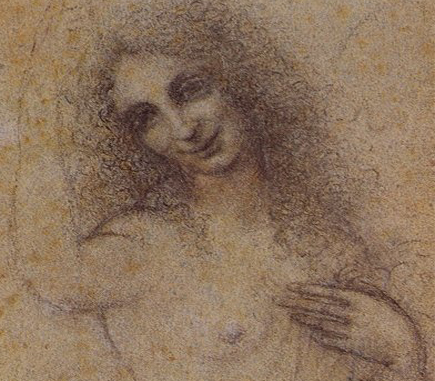
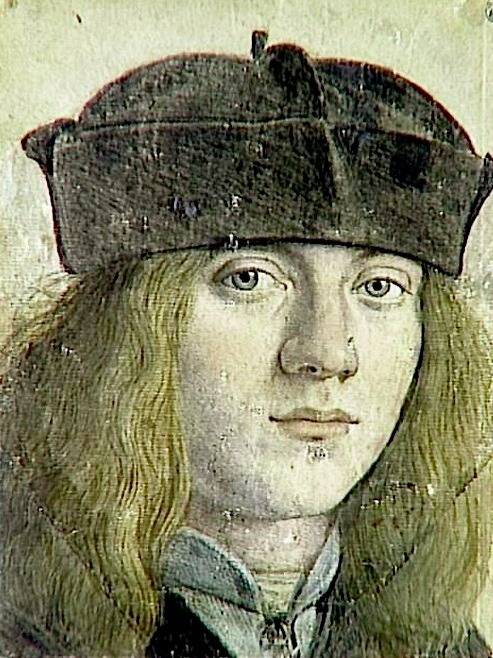
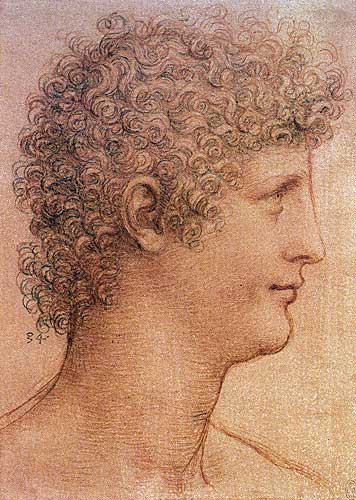
3. Leonardo’s Studio in Florence
In 1477, Leonardo left Verrochio’s studio after 10 years and set up his own. He was fairly successful, receiving several significant commissions. Leonardo’s studio collaborated on many works. Sometimes Leonardo would just add one vignette.
Leonardo was a notorious procrastinator and slow worker. He hated due dates and never finished his work. Dabbling in his multiple passions left him “impatient with the paintbrush.”
Leonardo left commissions unfinished, sometimes getting into legal trouble. He abandoned paintings at the sketch stage. Or was too busy working on mathematical experiments or dissecting cadavers.
At this time, Leonardo was part of the Medici court and living in the Medici Palace. Leonardo executed a famous drawing of the Pazzi Conspiracy, when the Pazzi family attempted a coup against the Medici and hung from the Palazzo Vecchio as punishment. Leonardo was also known to work in the gardens of the beautiful San Marco Monastery.
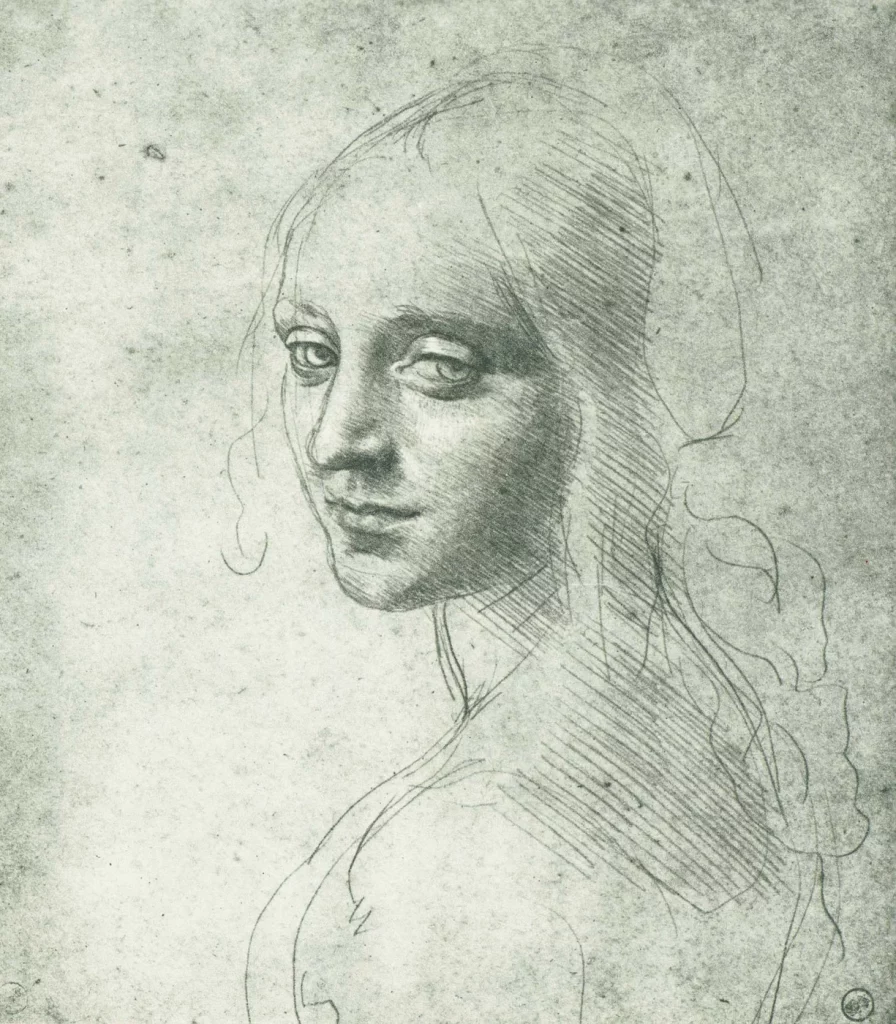
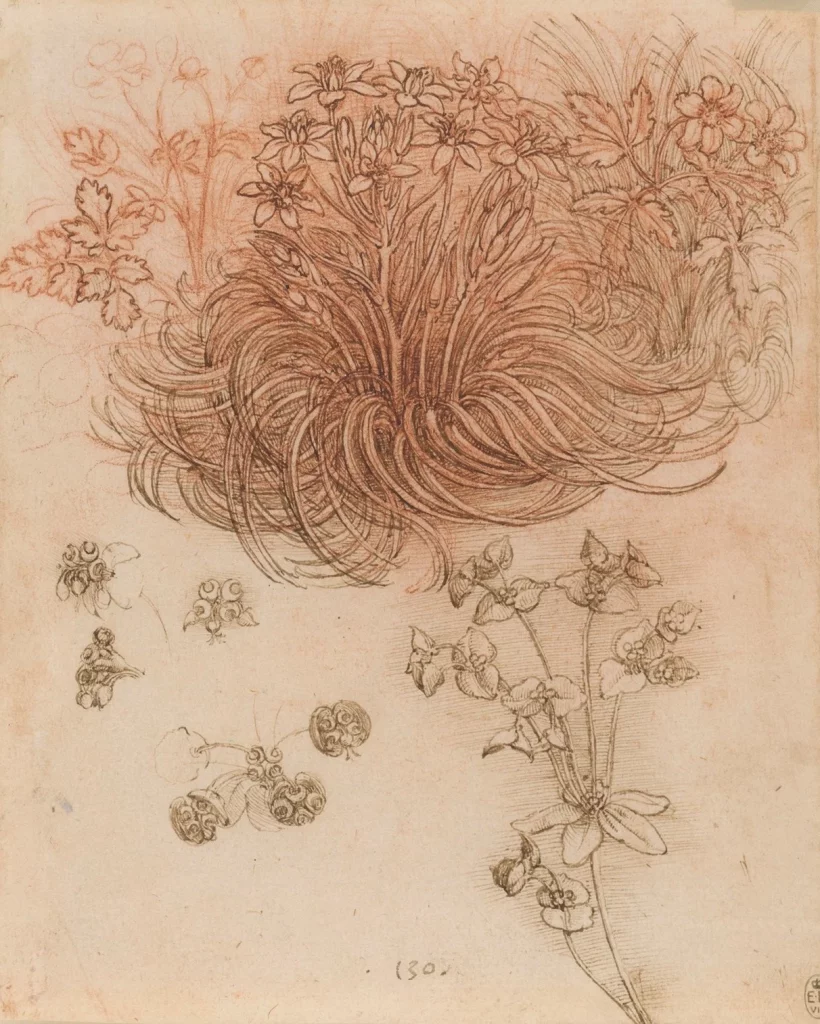
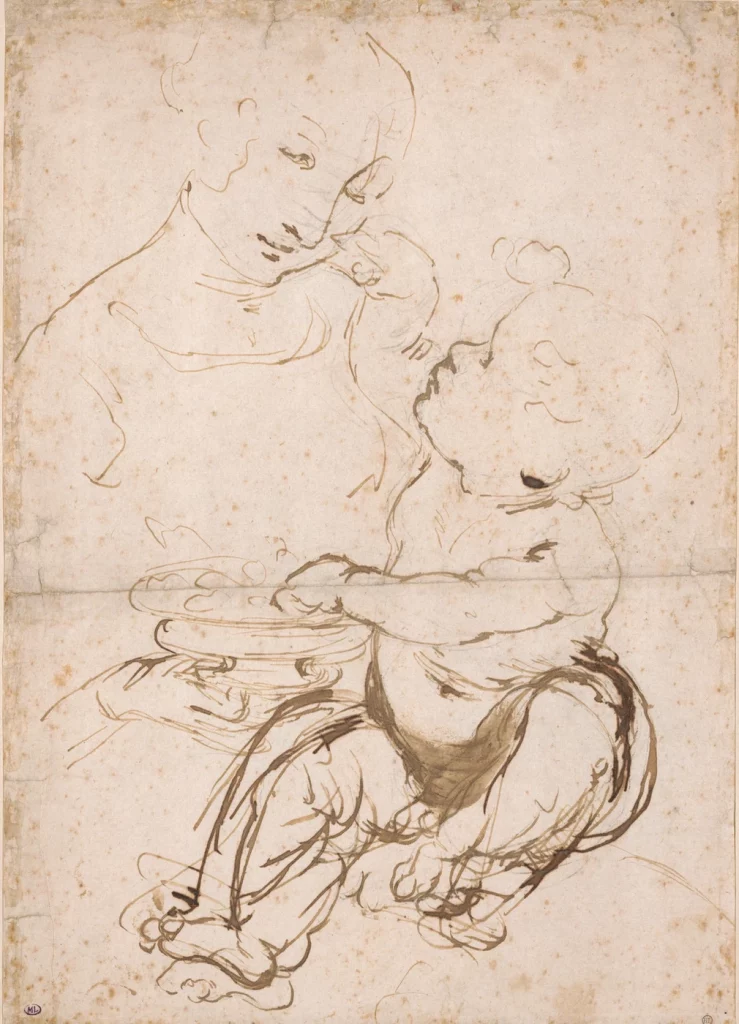
4. Leonardo Goes To Milan
In 1482, Leonardo moved to Milan and became a court painter for the Duke of Sforza. Leonardo lived in Milan for 18 years, producing some of his best works including Virgin of the Rocks and The Last Supper.
The hedonistic court life suited him. In Milan, Leonardo didn’t have strict deadlines for completion and became something of a dandy.
Leonardo eventually returned to Florence in 1500. He and his household stayed at the monastery of Santissima Annunciata. According to Vasari, it was in Florence that Leonardo painted St. John the Baptist and the Virgin and Child with St. Anne.
In 2005, Leonardo’s studio at the convent was discovered. The five rooms were frescoed with birds resembling those in his Atlantic Codex.
While popular, Leonardo still regularly failed to complete projects. Art historians think this was partly due to his ambition — the projects were just too colossal in concept to follow through. Leonardo also liked to work slowly, using layers upon layers of paint.
5. Leonardo’s Missing Battle of Anghiari Fresco
In Florence, Leonardo worked with Niccolò Machiavelli, a brilliant civil servant and author of The Prince, on several urban projects. Among Leonardo’s first painting commissions was a patriotic battle scene pitting Florence against Milan.
The Battle of Anghiari was intended to decorate the Hall of Five Hundred in the Palazzo Vecchio. It was a massive project, intended to be three times the size of The Last Supper. But, in 1506, Leonardo abandoned the project after completing only the central panel, when his experimental oils wouldn’t bond well to the wall.
There are reports of people flocking to the palace to admire Leonardo’s unfinished work, a sort of Renaissance Guernica showing the horrors of war. Artists came to inspect it and made copies. Some Leonardo preparatory studies exist. But the fresco itself vanished, becoming a “Lost Leonardo.”
Some art historians suspect the lost fresco is hidden behind later frescos by Giorgio Vasari from 1563. Legend holds that Vasari preserved Leonardo’s work by covering it with a false wall. In 1975, a researcher noticed a potential clue in Vasari’s fresco — the mysterious words “cera trove,” meaning seek and ye shall find.
In 2011, backed by National Geographic, engineers drilled 6 tiny holes into non-original paint in Vasari’s fresco. Initial high tech testing produced photos of brush strokes and traces of black pigment used by Leonardo.
But after a hue and cry, further investigation was halted for fear of damaging the Vasari frescos. Can you ethically perforate a Vasari fresco to find a Leonardo fresco?
Some historians now claim Leonardo never executed the Battle of Anghiari fresco, that the image only existed as a cartoon. Historic records show the Leonardo only purchased supplies for preparatory work, but no paint. It remains an art world mystery.
Around this time, Leonardo began work on his iconic Mona Lisa masterpiece. He worked on the painting incessantly the rest of his life, for 16 years, and took it on his travels. In 1506, Leonardo left Florence for good and returned to Milan to work on the Sforza equestrian statue.
6. Leonardo in France
In 1515, the young and art-loving French King Francis I — desperate for some Italian art — invited Leonardo to France. At the age of 64, Leonardo became the official court painter at Fontainebleau in France’s Loire Valley. The new job allowed Leonardo to live a life of leisure.
Unfortunately, due to health issues, Leonardo couldn’t paint with his former masterly finesse. In 1519, a frail Leonardo died at age 67, presumably of a stroke or heart attack, in the home the king gifted him, Chateau du Clos Luce.
READ: Guide to 20 Chateaux in France
A popular (and rather sweet) legend holds that Francois I was by his side, cradling his head. Leonardo’s lover, Melzi, inherited his estate and became the guardian of Leonardo’s treasures. Salai inherited several works, including the Mona Lisa, and sold them to the French king for a small fortune. This explains why so many Leonardos are in the Louvre.
Art and Legacy of Leonardo da Vinci
How did Leonardo influence the art world? His innovative compositions took early Renaissance works to a new level. Leonardo was especially good at making a flat panel look three dimensional.
His paintings and drawings were like magical super realism, drawn from nature. Leonardo’s subjects were expressive, portrayed against elaborate landscape backgrounds. They exude sensitivity, subtley, and intellect. You could see actual human emotions in his paintings.
Leonardo perfected chiaroscuro, the contrast and shading of light and dark, and became a master of linear perspective. Perhaps Leonardo’s greatest contribution was his sfumato technique, where he blended glazes to create a smoky blurred effect. Leonardo inspired high Renaissance painters like Raphael, Michelangelo, Filipino Lippi, and Andrea del Sarto.
Leonardo had an intense and bitter rivalry with Michelangelo. Well, it was mostly a young and arrogant Michelangelo who was detested Leonardo.
Michelangelo was 20 years younger than Leonardo — notoriously gruff, grumpy, and ill-kept. Leonardo was a legendarily peaceful dandy, in peacock clothes and perfume.
But jealously sparked inspiration for Michelangelo. Legend holds that Michelangelo carved his Pitti Tondo in response to Leonardo’s heralded Madonna with Child and St. Anne. Michelangelo also mocked Leonardo for failing to complete his equestrian statue in Milan.
But Leonardo exacted revenge. In 1504, to Michelangelo’s fury, Leonardo successfully argued to the City Council that Michelangelo’s marble colossus, David, needed a fig leaf garland on his genitals for modesty. This gave rise to the Vatican’s notorious “fig leaf campaign,” seeking to camouflage private parts visible in art across Italy.
Where To Find Leonardo’s Authenticated Paintings Around the World
Here’s a breakdown of Leonardo’s 15 authenticated paintings.
There are eight places in the world where you can find them, including many of the world’s best museums. The Louvre has by far the largest cache of Leonardos.
Louvre — Paris, France:
1. Virgin of the Rocks (1st version), 1483 (universally accepted)
There are two versions of this painting, both commissioned in Milan. Both paintings began to define the style of the High Renaissance.
The first one is in the Louvre. It shows the legend of St. John the Baptist meeting the holy family as they flee to Egypt to escape Herod’s Massacre of the Innocents. The painting has an elaborate and mystical landscape, with bizarre rock formations. The figures are grouped in a pyramid to give the illusion of space.
With a supernatural glow to her face, Mary is kneeling rather than being enthroned as the queen of heaven. For the first time in Renaissance history, the figures are missing halos and other indicia of the divine. This artistic departure made them seem more human and relatable to viewers.
You can contrast Leonardo’s two versions of The Virgin of the Rocks here, with the Louvre’s earlier version on the left.
2. La Belle Ferronnière, 1499 (widely accepted)
This painting depicts the first mistress of the Duke of Sforza, Lucrezia Crivelli, although some art historians think this painting is Isabella of Aragon. This may, or may not be, Leonardo’s work. But is generally widely accepted, if just because of the woman’s pose and extraordinary sideways penetrating glance.
The semi-profile pose revolutionized the genre of portraiture. At the time, severe unnatural profiles were the norm.
Women didn’t look directly at viewers and the viewer had no sense of the subject’s personality. In this painting, the woman turns her head in a twisting motion, giving a sense of movement and engagement.
The woman’s features are thicker than those found in Leonardo’s other portraits. Her hair was painted over by someone without any nuance.
Experts who favor this being an autograph Leonardo cite the steely gaze, the intricate knotted ribbons on her shoulders, and the cords around her neck. She’s also rendered with magnificent texture and light.
Possibly, La Belle Ferronniere is the work of an apprentice or a joint project executed by several artists at Leonardo’s studio based on a Leonardo design. Or, Leonardo may simply have been forced to do a traditional Milanese court portrait at the demand of his patron.
3. Mona Lisa, 1503-19 (universally accepted)
Without question, Leonardo’s most famous painting is the Mona Lisa. It’s among the first portraits to depict the sitter before an imaginary landscape using an aerial perspective.
Whatever the meaning of the portrait, Leonardo never relinquished it, carrying it with him at all times. The painting was in perpetual process. Year after year, Leonardo added small subtle and perfecting strokes and glazes.
Mona Lisa is reputedly a depiction of Lisa del Giaconda, an Italian noblewoman. She’s shown as seemingly ordinary young woman dressed modestly and delicately veiled. It seems like a vision of peace and harmony. But there’s that famously enigmatic smile. It’s a flirtatious and perplexing smile, slightly seductive.
Some theorists have been proposed that the model is Leonardo’s mother or his young lover Salai. (Mona Lisa is an anagram for Mon Salai.) Others posit that Mona Lisa is an androgynous composite portrait of a male and female. Leonardo experts and the Louvre dispute these fanciful claims.
The Mona Lisa wasn’t always so famous. The painting vaulted to superstar status when it was stolen by an Italian handyman named Vincenzo Peruggia, who worked at the Louvre.
News of the theft made headlines around the world. The Mona Lisa was missing for over two years and only recovered when Peruggia tried to sell it.
4. St. John the Baptist, 1513-16 (universally accepted)
St. John the Baptist is believed to be Leonardo’s last painting, perhaps not intended for audiences. There was no recorded commission.
Leonardo painted it for himself shortly before his death. In it, Leonardo depicts a strange image of St. John in the wilderness. who can be identified by the small wooden cross he holds.
St. John is executed and composed in Leonardo’s typical style, with a masterful sfumato technique. But he’s soft, smily, and semi-nude — as if under a street light. St. John looks directly at the viewer with a beguiling come hither smile.
In the painting, Leonardo famously elides gender, giving St. John a superabundant cascade of curls. Not surprisingly, some scholars speculate that it’s a portrait of Salai. But, as Leonardo, intended, we’ll never know for sure.
Then, there’s the question of St. John’s upraised finger, another Leonardo enigma. Does it point up to God, indicating the importance of salvation? Or does it move into openly erotic territory?
In support of the latter conjecture, this detail is eerily similar to a Leonardo drawing of Caprotti with an erection, called The Incarnate Angel. In any event, this “John Gesture” was copied by other artists, including Raphael in The School of Athens in the Vatican Museums.
In 2016, the Louvre cleaned and restored the painting. 15 layers of dark varnish were removed, revealing more details in the painting like the beautiful fur pelt.
5. Virgin, Child and St. Anne, 1503 (universally accepted)
Virgin and Child is one of Leonardo unsung triumphs. It’s among his last paintings and one that he spent 25 years perfecting. Commissioned by Louis XII, the painting was never delivered.
It’s a remarkably human and universal depiction of the multi-generational dynamic between grandmother, mother, and child. It’s full of movement and emotion, with three intertwined figures set against a blue crystalline landscape that’s pure Leonardo. Christ grapples with a lamb, symbolizing his Passion.
The tender painting is just as compelling and mysterious as the Mona Lisa. But it’s mostly ignored by the crowds, perhaps because, unlike the Mona Lisa, it was never stolen from Louvre with the ensuing publicity. The dark line on the left side of Mary’s shawl is evidence that Leonardo left the work unfinished.
Virgin and Child was meticulously cleaned and restored in 2010. The painting was given a celebratory exhibition in 2012, before being put back on permanent display in the Grand Gallery. It now glows luminously from the canvas, despite some controversy about possible over-cleaning and lightening.
National Gallery of Art – London, England:
6. Virgin of the Rocks (2nd version), 1508 (universally accepted)
This version of the Virgin of the Rocks was created in Milan and can now be found at the National Gallery of Art In London. Scholars know it’s a Leonardo because of an elaborate series of underdrawings detected by infrared reflectography tests.
It differs from the Louvre version in color palette and the depiction of the angels. In it, like his other, Leonardo portrayed Mary kneeling on the ground, rather than enthroned. The faces are contrasted with the very dark background. The figures are soft and graceful, giving the painting an ethereal feeling.
Of note, the National Gallery also owns one of Leonardo’s most famous cartoon drawings, The Burlington House Cartoon. It’s a charcoal on chalk drawing in eight pieces, presumed to be a rough draft for a painting, although no such painting has been discovered.
National Museum, Kraków, Poland:
7. Lady with the Ermine (Portrait of Cecilia Gallerani), 1489-91 (universally accepted)
Before the Mona Lisa, there was the Lady with the Ermine. This is an extremely beautiful work, one of my favorite Leonardos.
The Krawkow museum was founded in 1796 by Princess Izabela Czartoryski. In 1798, her son traveled to Italy and purchased Lady with the Ermine. It’s one of only four extant portraits of women painted by Leonardo. It even has his fingerprints on it.
Many art historians identify the woman in the painting as Cecilia Gallerani, a mistress of the the then future Duke of Milan and Leonardo’s patron. Originally, the painting had a light blue background. But it was painted over and given a dark background, characteristic of Milanese paintings.
The painting is both inscrutable and beautiful. The woman is shown as a figure of virtue, in understated attire gently holding her ermine. A smile dawns on her lips, giving a hint of drama to an otherwise tranquil scene.
Leonardo gave this traditional court portrait an unconventional twist, with a contrapposto pose. Her body faces right while her head faces left looking toward an unseen guest. It was very novel at the time to have an implied presence in a painting.
Usually seen as a symbol of virtue, the ermine has been the subject of much scholarly debate. The ermine could refer to Ludovico’s membership in the Order of the Ermine, it could be a play on Cecelia’s name in Greek, or it could simply have hidden her pregnancy.
The Lady with the Ermine has a colorful history. The Nazis seized it and took the painting to Berlin. In 1946, the Monuments Men recovered it and returned the painting to Poland, where she’s now a symbol of the country.
Vatican Museums, Pinacoteca – Vatican City:
8. St. Jerome, 1482 (universally accepted)
St. Jerome in the Wilderness is an unfinished and intimate masterpiece located in the Vatican Pinacoteca in the Vatican Museums. It’s typically Leonardo-esque, with masterful attention to human anatomy. As with the Mona Lisa, Leonardo kept St. Jerome with him until his death.
The painting is shrouded in mystery. We don’t know who commissioned it or why it was created. We don’t know why Leonardo didn’t finish it. Possibly, St. Jerome didn’t meet with his patron’s approval or Leonardo abandoned it due to his well known perfectionism.
In the painting, Leonardo depicts St. Jerome in prayer in a dynamic composition. Then a hermit in the desert, St. Jerome looks emaciated, self-immolating, and contemplative. A profound sorrow emanates from the painting. It’s an emotional and devotional piece.
St. Jerome was almost lost to the world. After its execution, Leonardo’s painting vanished. Napoleon’s uncle, Cardinal Joseph Fesch, discovered it by chance, in pieces, in two Roman shops. It was subsequently stitched back together, purchased for Pius IX, and installed in the Vatican Pinacoteca.
Why is St. Jerome important? Aside from being a rare Leonardo, it shows his classic style and innovation. Leonardo used his fingers to distribute the paint pigments (you can see the actual fingerprints in the upper left corner). This created a soft-focus sfumato landscape. It’s also a painting of intense psychological power.
Santa Maria Delle Grazie – Milan, Italy:
9. The Last Supper, 1498 (universally accepted)
The Last Supper is one of the world’s most iconic paintings, found on the back wall of the refectory (dining hall) in the monastery of Santa Maria delle Grazie. It was commissioned by Leonardo’s patron, Ludovico Sforza, the Duke of Milan.
No painting is so familiar, save for the Mona Lisa. The billboard size painting is a Renaissance masterpiece.
It shows the moment when Christ reveals that one of his apostles will betray him. He then institutes the Eucharist. Leonardo portrays each apostle’s unique reaction to his declaration — horror, anger, grief, shock, etc.
The scale of The Last Supper is enormous — 29 feet wide by 15 feet tall. Not only is The Last Supper famous, it’s a fascinating and spellbinding artwork surrounded by mysteries and legends. The Last Supper is as renowned for its fragility as its power.
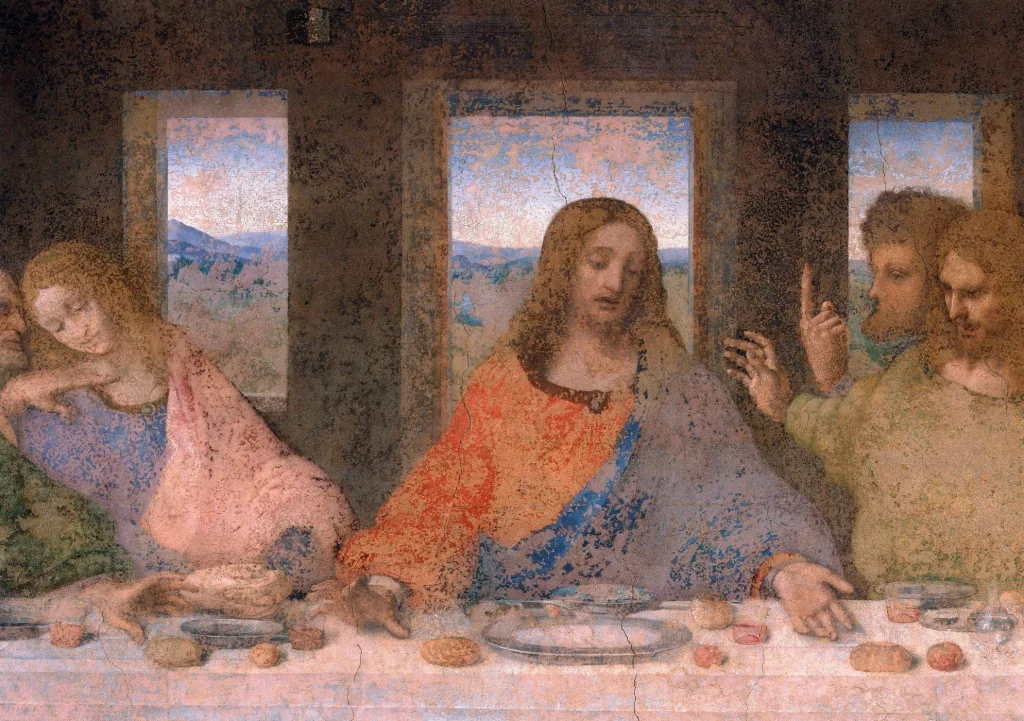
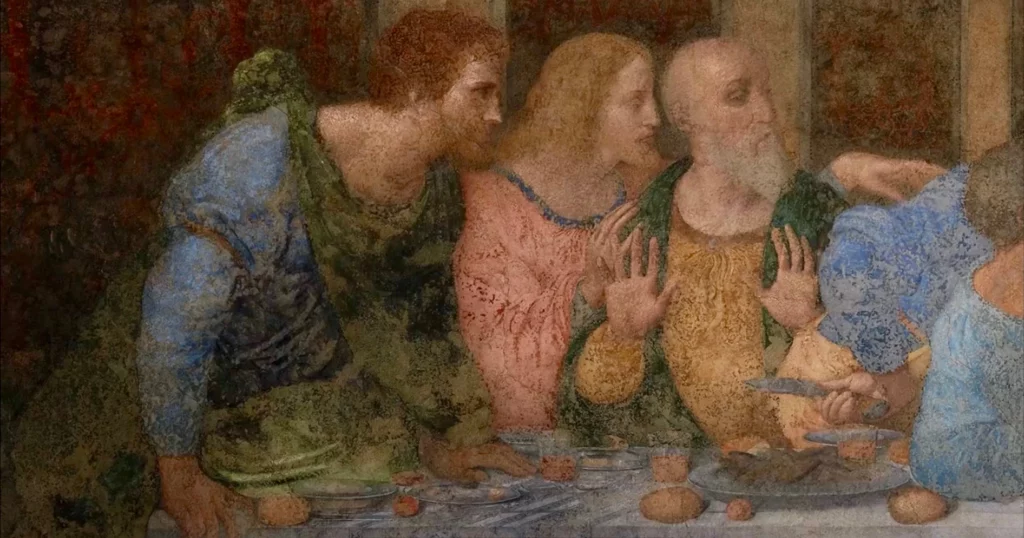
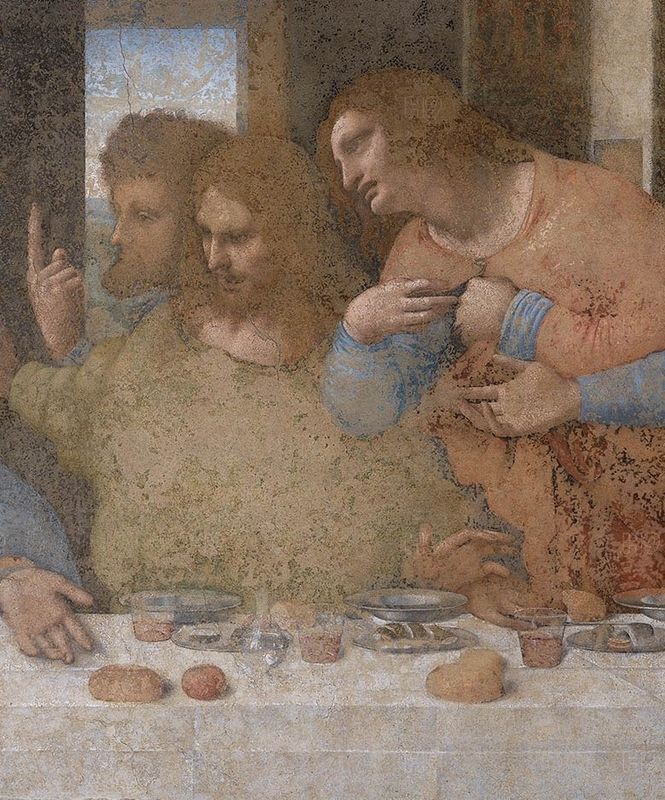
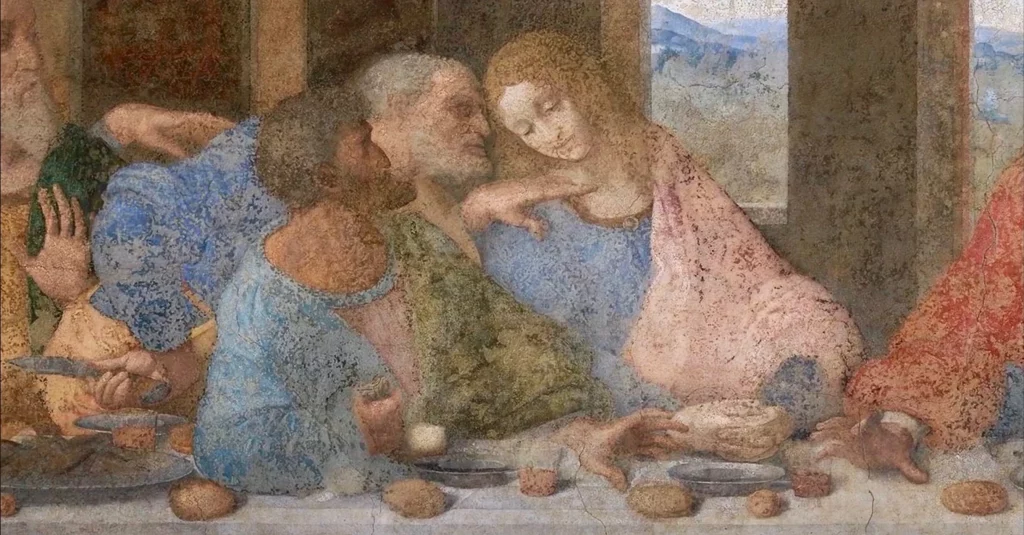
The fresco is largely a failure, a bit of a self-obliterating wreck. Completed in 1594, The Last Supper began flaking off the wall in 1517.
Because Leonardo painted in secco fresco (dry) instead of buon fresco (true), the painting began to deteriorate immediately. It’s a violent art history tale of great triumph and tragedy.
You’ve got to be organized and reserve in advance to see this quasi-restored, yet still beautiful, masterpiece. Advance reservations are mandatory.
Here’s my guide to The Last Supper. It contains an analysis of the painting, practical information and, must know tips on how to see Leonardo’s famous painting.
Uffizi Gallery – Florence, Italy:
10. The Annunciation, 1472-80 (widely accepted)
Leonardo completed The Annunciation in his early twenties and it’s housed in the Uffizi Gallery. It’s considered his first major work.
In it, Mary reads at a richly decorated desk carved from marble. The angel Gabriel arrives, lily in hand, to announce that Mary will be the mother of Jesus.
Leonardo’s stylized painting is different from his predecessors’ treatment of the theme. Most significantly, the scene takes place outdoors in an enclosed garden, with a landscape backdrop. This reflects Leonardo’s use of visual naturalism and perspective.
However, the painting’s provenance is a little murky. The painting has also been attributed to Domenico Ghirlandaio (Michelangelo’s teacher) and Lorenzo di Credi. Both were apprenticed to Andrea del Verrocchio’s workshop at the same time as Leonardo.
It’s likely that Annunciation is a collaborative work of several artists, with the finishing touches completed by Leonardo. It was a common enough practice at the time. But the landscape, sfumato technique, and the figure of Gabriel (with his electrifying wings) look distinctively Leonardesque. And a prepratory drawing for Gabriel’s sleeve has been attributed to Leonardo.
11. Adoration of the Magi (unfinished), 1481 (universally accepted)
Adoration of the Magi is an early unfinished oil painting by Leonardo, his largest surviving panel. In 1481, Leonardo was given the commission by the Augustinian monks of San Donato in Scopeto in Florence.
But he left for Milan the following year, leaving the painting mostly unfinished. The Medici acquired it for their collection in the 1500s.
In the complicated painting, Christ has just been born. Three kings come and offer three gifts. Mary and Christ are in the center in a triangular form. The painting is chaotic, with many competing narratives.
What’s revealed in the underpainting is Leonardo’s working method and creative process. You can see the way he constructs features. You have a sense of his deep understanding of human anatomy. You can also see Leonardo’s blurry sfumato technique, creating an atmospheric smokiness and softness.
In 2012, the Adoration of the Magi’s dark murky surface received a six year restoration. The restoration cleaned off layers of dirt and non-original varnish. You can now see the original colors and the expressions of its characters.
National Gallery – Parma, Italy:
12. Head of a Woman aka La Scapigliata, circa 1500 (unfinished) (widely accepted)
Executed during Leonardo’s mature period, this tiny unfinished portrait remains largely a mystery. It’s halfway between preparatory drawing and formal panel painting, housed int he National Gallery of Parma.
We don’t know who it was, who commissioned it, or its provenance. It’s mentioned for the first time in the House of Gonzaga collection in 1627. What we do know is that, in Italian, La Scapigliata means “disheveled.”
La Scapigliata is a classic Leonardo portrait. It’s full of soft lines and gentle shading. The painting is subtle — full of nuanced emotion, rather unfathomable, and meditative.
Leonardo wasn’t just depicting a disheveled woman, but rather showing her natural beauty, sweet features, and curious inner light. As with the Mona Lisa, he suggests that there is more than what’s on the surface.
National Gallery of Art – Washington, DC, USA:
13. Portrait of Ginevra de’Benci, 1472-78 (universally accepted)
This is an early Leonardo portrait, possibly an engagement portrait. It’s the only Leonardo painting in the United States and was a watershed in Italian Renaissance portraits.
Ginevra was the teenage daughter of a wealthy Florentine banker. The portrait is one of Leonardo’s early experiments with the new medium of oil paint and psychological elements.
The 3/4 pose is an Italian Renaissance first. Ginevra’s face, while a bit severe, is characteristic of a new naturalism that would pervade the Renaissance. At that time, it was rare for a woman to look at the viewer. But for the first time, Leonardo’s Ginevra looks directly at you and is incorporated into her own landscape.
Departing from precedent, Leonardo placed Ginevera in an open setting, not a sheltered room in her home. The shimmering blue landscape isn’t just a backdrop. Leonardo makes it a living thing.
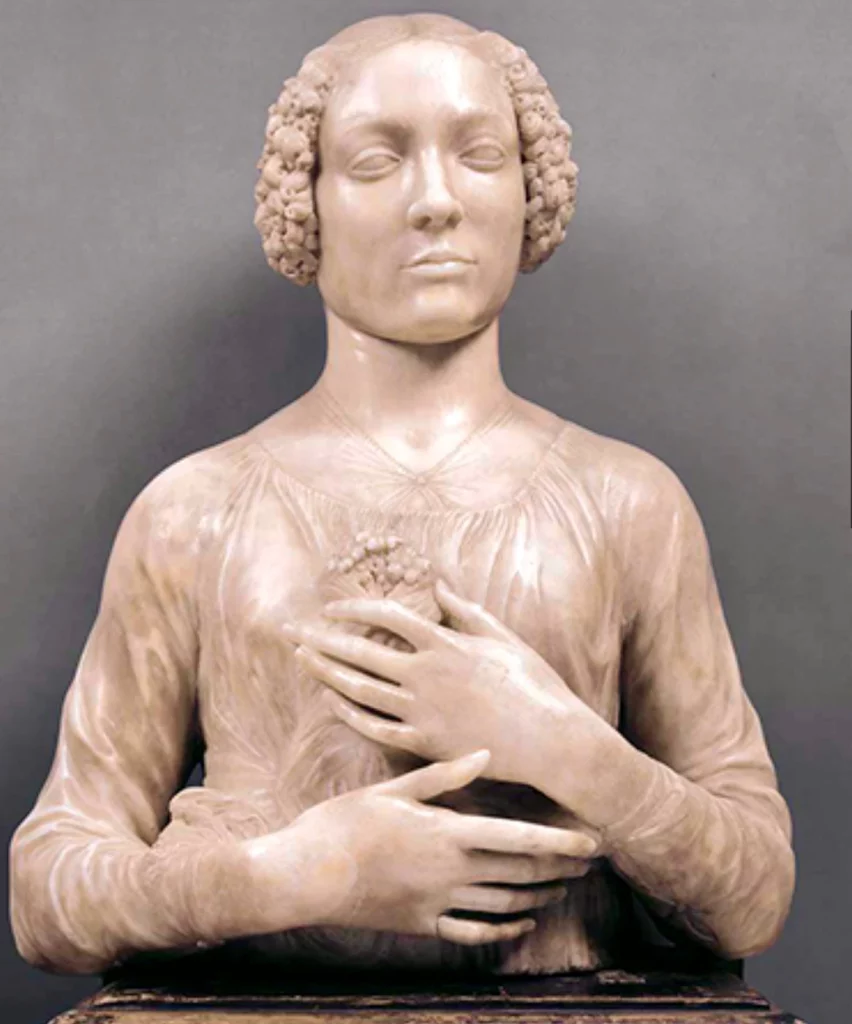
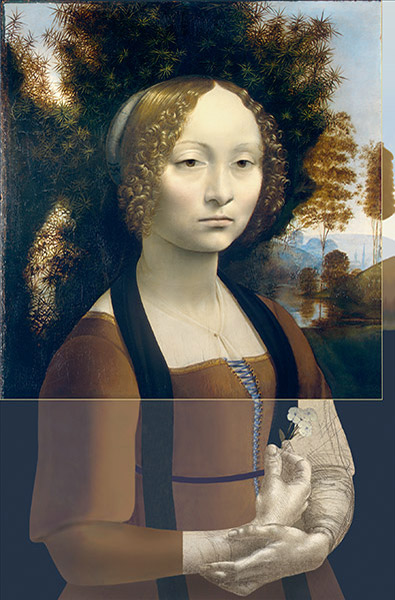
At some point, Ginevra’s hands were cut off and the picture shortened. Originally, Ginevra was shown at nearly waist length with her hands delicately holding a sprig of flowers.
This innovative design was unprecedented in Florentine female painted portraiture of the period. It was likely inspired by Leonardo’s teacher Verrocchio’s marble busts.
Verrochio’s revolutionary Lady with Flowers of the same period portrays a young woman with her hands crossed, holding a bouquet of primroses to her chest.
Hermitage Museum, St. Petersburg, Russia:
14. Madonna of the Flower aka The Benois Madonna, 1475-80 (widely accepted)
Russia possesses two Leonardo, dubbed the “Russian Leonardos.” The first one, the Benois Madonna, is an apparent early Leonardo. It’s reputed to be Leonardo’s first independent work after leaving Verrocchio’s studio. Two authenticated preliminary sketches are in the British Museum in London.
The painting was only “discovered’ in 1909. It’s called the Benois Madonna because Leon Benois sold it to the Tsar Nicholas II for Hermitage Museum in 1914. At the time, the painting had resurfaced suddenly after having been missing for centuries.
While the less than inspiring painting isn’t very appealing to me, it was assiduously copied by the young painters of the time including Raphael. It’s an uncharacteristically happy scene (for the time) of a mother’s precious love for her child. Mary is no longer an imperturbable queen of the heavens, but a simple mother.
Although charming, the Benois Madonna isn’t Leonardo’s best work. The ears and hands are rather clumsy and the forehead bald, not typical of Leonardo’s attention to anatomy. And the Virgin’s smile is rather aggressive and impressionistic. The baby Jesus sits awkwardly on her lap.
The Benois Madonna is widely accepted as a genuine Leonardo. But it’s a very early work, with much less complexity and detail than his subsequent works.
15. Litta Madonna, circa 1490 (generally accepted, but disputed)
The provenance of the Litta Madonna is hotly disputed. It’s documented that Leonardo did preparatory drawings for the painting. But whether he actually painted it is still a matter for debate.
The colorful painting shows the Virgin Mary nursing her baby in a dark interior, against a mountainous landscape. Baby Jesus holds a goldfinch in his left hand, a symbol of the future Passion of Christ.
The painting’s name comes from the fact that it was in the collection of the Milanese Litta family for much of the 19th century. In 1865, Tsar Alexander II acquired it for the Hermitage.
Most Leonardo experts claim the painting is a workshop product based on a Leonardo design. They believe Leonardo’s pupil, likely Bernard Boltraffio, created the finished product. The outlines are rather rigid for Leonardo and the background is unremakarble.
Difficulty of Authenticating a New Leonardo
In the last decade or so, bombshell discoveries of previously “Lost Leonardos” have shocked the art world. Names don’t come much bigger than Leonardo. To find a new, heretofore undiscovered, Leonardo trophy is to strike the purest vein of gold.
But it takes a mountain of evidence for a Leonardo to be deemed universally authentic. A painting must do more than “hover between realms” to be accepted. Unfortunately, provenance assessments aren’t always black and white.
In the Renaissance, artists operated studios where multiple artists might work on a single piece. It was the tradition for Leonardo to ask for studio help. Or, Leonardo might touch up his apprentice’s pieces before selling them. Leonardo also worked slowly, while his apprentices copied his in-progress pieces.
So, the precise attribution of X painting to X artist is rife with difficulties, even with forensic assessments. The bottom line is that disputed paintings may simply be the work of Leonardo and another artist, requiring dual attribution.
There’s also the sticky wicket that Leonardo’s works evolved over time. Leonardo approached every work differently and was always trying new techniques.
So judging a newly-discovered Leonardo purely against his mature stage work isn’t quite right. There are probably more works in his canon than are generally accepted.
Is It An Autograph Leonardo? Recent Disputed Leonardos that Remain in Flux:
Here are six famous paintings falling into the “Leonardo or no industry,” that may be only partially or not at all by the master himself:
1. Salvator Mundi, circa 1500, Parts Unknown (disputed)
Kicking off the Leonardo art thriller extravaganza is Salvatore Mundi (Savior of the World). In 2017, Salvator Mundi, a painting attributed to Leonardo, stunned the art world. It sold for the almost cartoonish price of $450 million at Christie’s in New York.
With a bang of the gavel, Salvator Mundi became the world’s most expensive painting. By far. The shockingly high price reflected the extreme rarity of Leonardos. The likely buyer? The notorious Crown Prince Mohammed bin Salmon of Saudi Arabia.
Because preparatory sketches were known to exist, Salvator Mundi was considered a “Lost Leonardo” for many decades. Prior to its rediscovery, no Leonardo painting had been found since 1909. The last one was the Benois Madonna.
Despite its high price tag, Salvator Mundi has been plagued with provenance and authenticity questions since its unlikely “rediscovery.”
It was found badly damaged. Then, it was significantly overpainted and restored before it was sold. Many experts attribute the work to Leonardo’s most gifted pupil, Boltraffio.
The leading Leonardo expert, Martin Kemp, believes Salvator Mundi may be a real Leonardo. There’s evidence of a pedimento (a painted over “regret”), preparatory drawings match the painting, the colors are startlingly similar to the second Virgin of the Rocks, and there’s a hand print. All these facts point to the presence of Leonardo.
And, in fact, no one seriously doubts that Leonardo was somehow involved. But there’s as many reasons to reject the attribution as to accept it. The painting therefore exists in a blurry zone — stuck between being a bona fide Leonardo, a partial Leonardo, or a vastly less valuable Leonardo workshop piece by students.
The Louvre was hopeful that it could display Salvator Mundi in its blockbuster Leonardo exhibition in 2019. Rumors circulated that the Louvre doubted its attribution. In fact, the prince had shipped the Salvator Mundi to the Louvre in 2018 for evaluation.
The prince insisted that Salvator Mundi be labelled as “100% Leonardo” and placed next to the Mona Lisa for the exhibition. President Macron rejected these conditions. In a huff, the prince then refused to loan the picture.
Since then, a secret Louvre booklet was leaked. It had been prepared in case the painting were exhibited. In it, after extensive scientific examination, the Louvre confirms the attribution to Leonardo.
The Louvre kept its findings secret after the squabble with the prince. The Louvre hasn’t publicly commented on its judgment. So it’s a standoff. The French refuse to discuss the painting and the Saudis refuse to show it.
2. The Beautiful Princess aka La Bella Principessa, circa 1480-90, private collection (disputed)
This hitherto unknown and disputed Leonardo painting was authenticated by Martin Kemp in 2008. It’s been endorsed by another half dozen scholars. Kemp believes the painting is a profile portrait of Bianca Sforza, noting that “her face is subtle to an inexpressible degree.”
What the evidence? It’s all circumstantial. The painting was carbon dated to Leonardo’s era, the artist (like Leonardo) was likely left handed, and the perspective is flawless. The bound braid pony tail was a style introduced in Milan by Ludovico’s wife, Beatrice d’Este.
To top that off, after scanning, investigators discovered a fingerprint that is “highly comparable” to a fingerprint on Leonardo’s St. Jerome. And the subject’s eye is favorably compared to this in Leonardo’s Lady with the Ermine.
Nonetheless, the painting has so far failed to win over the majority of the art establishment. There’s no historical record. The subject is shown in strict profile, when Leonardo had already broken away from profiles with his Portrait of Ginevra de’Benci. Kemp, experts say, succumbed to the “Lost Leonardo” fantasy.
The painting also lacks the theatricality, emotional expressiveness, and anatomic accuracy of Leonardo’s authenticated works. And it was painted on vellum, a material Leonardo never used. So, much like Salvator Mundi, La Bella Principessa is either a run of the mill Leonardo pastiche worth thousands or a real Leonardo worth many millions.
3. Madonna of the Carnation, Alte Pinakothek, Munich, 1478-80 (becoming more generally accepted)
This painting has spent most of its life attributed to Verrocchio. It has a slightly Venetian flavor. In 1469, Verrocchio made a trip to Venice, closely followed by Leonardo.
The paintings could be a very early Leonardo work. And it’s quite similar to the Benois Madonna.
The quality of painting is high. The handling of the drapery and the background landscape are characteristic of Leonardo. Scholars are beginning to accept this painting as a real Leonardo, though its attribution rests on another slightly dubious work.
4. Portrait of Isabella d’Este, Pinacoteca Ambrosiana, Milan (disputed)
There’s no doubt that Leonardo did a charcoal sketch of Isabella d’Este, the Marquess of Mantua. It’s been authenticated and is in the Louvre. It’s considered one of Leonardo’s finest portrait drawings. There are other artists’ copies of it in the British Museum and the Uffizi Gallery.
And we know from letters that Isabella repeatedly asked Leonardo to make an official portrait from the sketch. But did he ever complete one? If he did, is it another “Lost Leonardo”?
In 2013, a richly colored canvas portrait obviously based on the sketch was discovered in a private bank vault in Switzerland. Some believe it’s the oil version of Leonardo’s sketch.
The painting was carbon dated to Leonardo’s era and executed with pigments that Leonardo used. Isabella has Leonardo’s trademark enigmatic smile. It’s currently in the Ambrosiana Museum, and a top masterpiece to see in Milan.
One of the world’s foremost Leonardo experts, Carlo Pedretti, has vouched for the painting’s authenticity. Though he concedes that some details (the lily, crown, and apparent wheel) were likely added/overpainted by students to create the iconography of Saint Catherine of Alexandria.
Of more importance is the appearance of a closed book in both sketch and oil. In the painting, it’s under the overpainted wheel. In Leonardo’s sketch, the book is now hidden and obscured by the passage of time and only detectable by scans.
But others disagree. There’s no historical documentation of the painting, which doesn’t have Leonardo’s usual subtley.
It’s also painted on canvas, not the wood Leonardo preferred for oils. And Leonardo’s pupils had access to his sketches, so could easily have tried their hand.
5. Portrait of a Musician, 1483-87, Pinacoteca Ambrosiana (disputed but experts are coming around)
The Ambrosiana also houses Portrait of a Musician, another disputed but well-preserved Leonardo. The unfinished painting was originally billed as a “school of Luini” painting. In 1798, the museum changed the attribution to Leonardo. Controversy surrounds the painting. It would be Leonardo’s only known portrait of a man.
Many factors weigh against the off key painting’s authenticity. It’s mostly unfinished with some overpainting and lacks any historical documentation. There’s no record of anyone commissioning the painting>
The subject is unidentified. The hand was added later and everything below the face is stiff and clumsily rendered.
Other scholars claim the meditative face was painted by Leonardo. They suggest that the man is a Tuscan musician, who was a friend of Leonardo. And they believe that the sheet of music in the subject’s hand (uncovered during restoration) contains a cryptic inscription, which is a classic Leonardo hidden message.
6. Isleworth Mona Lisa, 1503-06, privately owned (disputed)
Did you know that some historians suspect the Louvre’s Mona Lisa is a copy of an earlier version? There’s another painting of the same woman, Lisa del Giocondo, allegedly painted a decade or so before the Louvre’s version. Was this Leonardo’s prequel?
The lookalike painting was initially dubbed the “Isleworth Mona Lisa.” Isleworth was the studio of maverick English connoisseur Hugh Blaker, who spotted the painting in an old manor house. It’s now been rebranded as the “Earlier Mona Lisa.”
The painting is owned by a consortium of Swiss businessmen. Though there’s a dispute in the Italian court over ownership, with a London family making a partial claim.
The two paintings bear a startling resemblance, though the “Earlier Mona Lisa” has been cleaned and restored. Leonardo often made two versions of many masterpieces.
Giorgio Vasari refers to the Mona Lisa as “unfinished” while the Louvre’s Mona Lisa is clearly finished. The Isleworth version has columns. These same columns are found in a Raphael sketch, made after visiting Leonardo’s studio where he may have seen the painting.
But most da Vinci experts think the Isleworth Mona Lisa is just another in a long series of Mona Lisa variants and imitations. It’s a tedious and stilted copy with a subpar background and no telltale underdrawings. Kemp gave it a critical smack down. Skepticism remains the order of the day.
I hope you’ve enjoyed my guide to the paintings of Leonardo da Vinci. here are some of my other guides to amazing art in Europe.
- Best Cities for Art In Europe
- Guide to the Uffizi Gallery
- Masterpieces of the Vatican Museums
- Guide to Rome’s Borghese Gallery
- Underrated Masterpieces of the Louvre
- Best Museums in Florence
- 30 Must See Paintings in Florence
- Best Museums in Rome
- 10 Secret Museums in Paris
- Leonardo’s Last Supper in Milan
- All The Last Supper Paintings From Renaissance Italy
If you love Leonardo da Vinci, pin it for later.

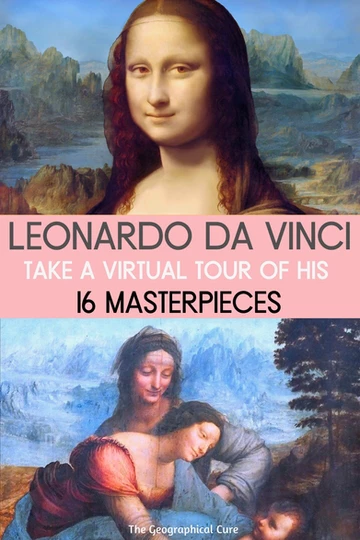
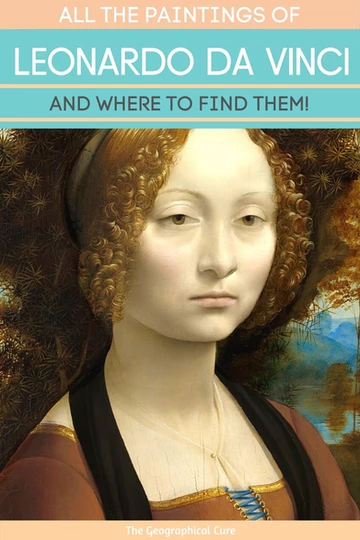
You know,
Isn’t it interesting how one story will say, that Da Vinci didn’t keep journals and another will say, that Da Vinci was famous for writing from right to left… in his journals?
I am of the opinion, Da Vinci did not exist, that he was made up; He was created by the “The Vatican” so that they could plagiarize God.
Crazy, right?
Yup, there are so many da Vinci theories.
I visited the National Gallery in London today and had a Google this eve to find out more about Leonardo’s works and where I can view them. Thanks for the detailed and informative post.
You’re welcome! Love the National Gallery.